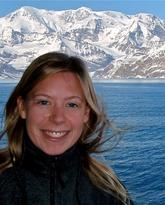
Mindi Summers
Instructor, Ecology and Evolutionary Biology, Department of Biological Sciences
Faculty Member
BSc (Hons) – Geological and Environmental Sciences
MSc – Marine Biology
PhD – Oceanography
Contact information
Phone
Location
Courses
Zoology 401 – An Introduction to Invertebrate Zoology
Biology 401 – Evolutionary Biology
Zoology 435 – Entomology
Zoology 567 – Animal Behaviour
Biology 520 – Field Course in Tropical Biology
BMSC – Marine Invertebrate Zoology
Research and teaching
Research areas
- Ecology and Evolutionary Biology
Biography
Dr. Mindi Summers is an invertebrate zoologist and biology education researcher. She completed her Bachelors of Science with Honors at Stanford University, and MS and PhD at Scripps Institution of Oceanography. Her dissertation work focused on uncovering the relationships among marine symbionts, focusing on crinoid hosts and their many associates (e.g., myzostomid annelids, eulimid gastropods, scaleworms, squat lobsters, snapping shrimp, and clingfish) using molecular phylogenetic approaches. For her postdoctoral work, Dr. Summers studied student learning in biology and developed a suite of programmatic assessment tools and instructional interventions.
At the University of Calgary, Dr. Summers teaches courses in invertebrate zoology, evolution, animal behaviour, and research methods in zoology. She also co-teaches a six-week field course in marine invertebrate zoology at Bamfield Marine Science Centre. Dr. Summers' research currently focuses on best practices to incorporate authentic research experiences into undergraduate courses, facilitating creativity in science, and documenting and disseminating information on Calgary biodiversity.
Dr. Summers is also an HPI Faculty member.
Publications
Branchaw JL, Pape-Lindstrom PA, Tanner KD, Bissonnette SA, Cary TL, Couch BA, Crowe AJ, Knight JK, Semsar K, Smith JI, Smith MK, Summers MM, Wienhold CJ, Wright CD, & Brownell SE. 2020. Resources for teaching assessing the Vision and Change biology core concepts. CBE-Life Sciences. 19(2). https://doi.org/10.1187/cbe.19-11-0243.
McKay DM, Summers M, Buret AG, Emmett T, & Gilleard JS. 2019. Rethinking graduate education in parasitology: a case study. Trends in Parasitology. 35(9): 665-668. https://doi.org/10.1016/j.pt.2019.05.001
Smith MK, Holmes NG, Walsh CW, & Summers MM. 2019. Using EcoEvo-MAPS to assess student thinking across the Four Dimensional Ecology Education (4DEE) framework. Ecosphere. 10(9). https://doi.org/10.1002/ecs2.2873.
Smith MK, Brownell SE, Crowe AJ, Holmes NG, Knight JK, Semsar K, Summers MM, Walsh CW, Wright CD, & Couch BA. 2019. Tools for change: Measuring student conceptual understanding across undergraduate biology programs using Bio-MAPS assessments. JMBE. 20(2). https://doi.org/10.1128/jmbe.v20i2.1787.
Couch BA, Wright CD, Freeman S, Knight JK, Semsar K, Smith MK, Summers MM, Zheng Y, Crowe AJ, & Brownell SE. 2019. GenBio-MAPS: A programmatic assessment to measure students understanding of Vision and Change core concepts across general biology programs. CBE-Life Sciences. 18: 1-14. https://doi.org/10.1187/cbe.18-07-0117
Semsar K, Brownell S, Couch B, Crowe A, Freeman S, Smith M, Summers M, Wright C, & Knight J. 2019. Phys-MAPS: A programmatic physiology assessment for introductory and advanced undergraduates. Advances in Physiology Education. 43: 15-27. https://doi.org/10.1152/advan.00128.2018
Summers MM, Couch B, Knight J, Brownell S, Crowe A, Semsar K, Wright C, & Smith MK. 2018. EcoEvo-MAPS: a tool to assess student learning in ecology and evolution through the undergraduate major. CBE-Life Sciences Education. 17: 1-12. LSE Issue Highlighted Article. https://doi.org/10.1187/cbe.17-02-0037
Smith MK, Toth ES, Borges K, Dastoor F, Johnston J, Jones EH, Nelson PR, Page J, Pelletreau K, Prentiss N, Roe JL, Staples J, Summers M, Trenckmann E, & Vinson E. 2018. Using place-based economically relevant organisms to improve student understanding of the roles of carbon dioxide, sunlight, and nutrients in photosynthetic organisms. CourseSource. https://www.coursesource.org/courses/using-place-based-economically-relevant-organisms-to-improve-student-understanding-of-the
Trenckmann E*, Smith MK, Pelletreau KN, & Summers MM. 2017. An active-learning lesson that targets student understanding of population growth in ecology. CourseSource. https://www.coursesource.org/courses/an-active-learning-lesson-that-targets-student-understanding-of-population-growth-in-ecology
Summers MM, Messing CG, & Rouse GW. 2017. The genera and species of Comatulidae (Comatulida: Crinoidea): taxonomic revisions and a molecular and morphological guide. Zootaxa. 4268: 151-190. https://doi.org/10.11646/zootaxa.4268.2.1
Rouse GW, Lanterbecq D, Summers MM, & Eeckhaut I. 2016. Four new species of Mesomyzostoma (Myzostomida, Annelida). Journal of Natural History. 50: 1-23. https://doi.org/10.1080/00222933.2015.1056266
Summers MM, Pleijel F, & Rouse GW. 2015. Whale falls, multiple colonisations of the deep, and the phylogeny of Hesionidae (Annelida). Invertebrate Systematics. 29: 105-123. https://doi.org/10.1071/IS14055
Summers MM & Rouse GW. 2014. Phylogeny of Myzostomida (Annelida) and their relationships with echinoderm hosts. BMC Evolutionary Biology. 14: 170. https://doi.org/10.1186/s12862-014-0170-7
Summers MM, Messing CG, & Rouse GW. 2014. Phylogeny of Comatulidae (Echinodermata: Crinoidea: Comatulida). Molecular Phylogenetics & Evolution. 80: 319-339. https://doi.org/10.1016/j.ympev.2014.06.030
Summers MM, Al-Hakim I, & Rouse GW. 2014. Turbo-taxonomy: 21 new species of Myzostomida (Annelida). Zootaxa. 3873: 301-344. http://dx.doi.org/10.11646/zootaxa.3873.4.1
Summers MM, Katz S, Allen EE, & Rouse GW. 2013. Association of rhizobia with a marine polychaete. Environmental Microbiology Reports. 5: 492-498. https://doi.org/10.1111/1758-2229.12043
Payne JL, Summers M, Rego BL, Altiner D, Wei J, Yu M, & Lehrmann DJ. 2011. Early and Middle Triassic trends in diversity, evenness, and size of foraminifers on a carbonate platform in south China: implications for tempo and mode of biotic recovery from the end-Permian mass extinction. Paleobiology. 37: 409-425. https://doi.org/10.1666/08082.1
